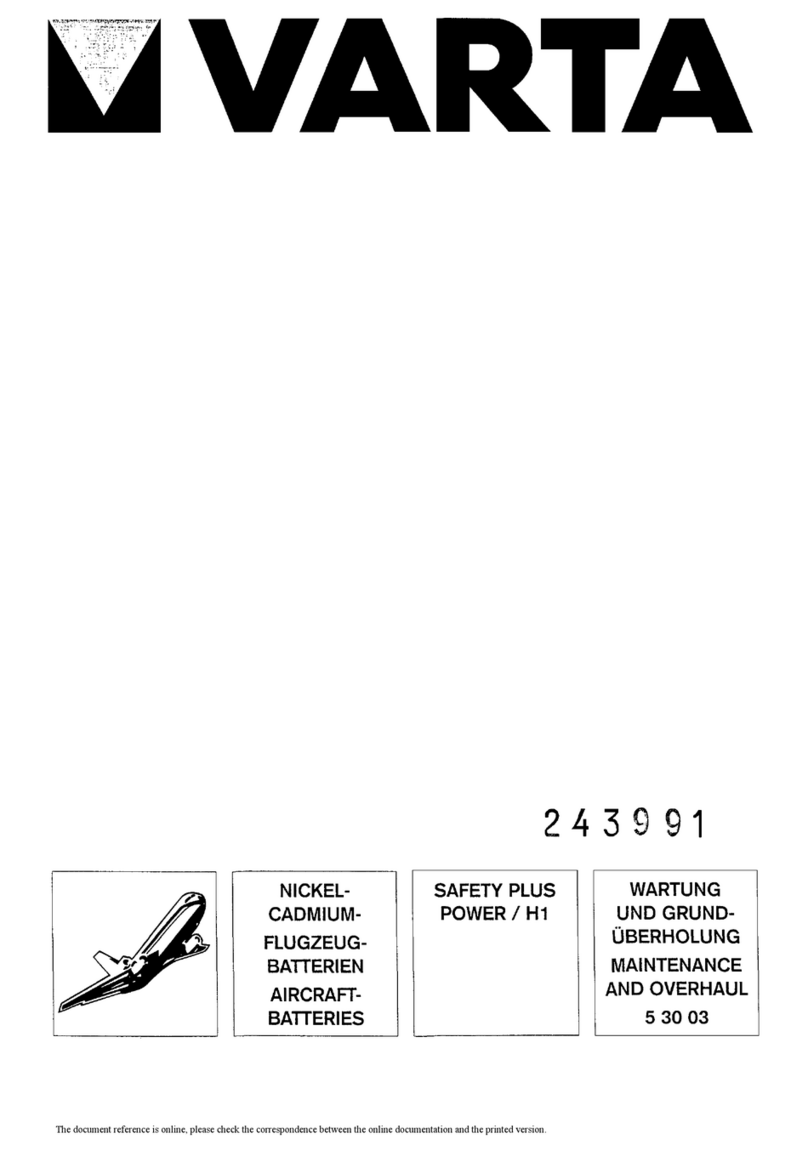
1. Transport
Die VARTA PROFESSIONAL DC AGM (mit AGM-Technologie) erfüllt die
Anforderungen an Auslaufsicherheit der UN2800. Daher gilt eine AGM-Batterie
nicht als gefährlichesTransportgut. Dessen ungeachtet muss die Batterie
gegen Kippen, Kurzschluss, Verrutschen und Beschädigung gesichert werden.
Kurzschlüsse sind zu vermeiden, da die Batterien eine extrem hohe Leistung
haben und die Gefahr der Entzündung besteht.
Lassen Sie die Anschlussabdeckungen an Ort und Stelle.
Lassen Sie die Entgasungsöffnung offen.
2. Einbau in das Fahrzeug und Ausbau aus dem Fahrzeug
- Richten Sie sich immer nach der Betriebsanleitung des Fahrzeugs.
- Batterien, die gefüllt ausgeliefert werden, sind gebrauchsfertig.
- Achtung! Unterbrechung der Spannung kann zur Fehlfunktion diverser
elektrischer Komponenten führen (Wegfahrsperre, Radio etc.).
- Bauen Sie nur ausreichend geladene Batterien ein (Minimum 12,50 Volt
Ruhepannung).
- Schalten Sie vor Ausbau der Batterie alle elektrischen Systeme aus.
- Trennen Sie bei Ausbau der Batterie zuerst den negativen Anschluss (–), dann
den positiven Anschluss (+).
- Säubern Sie vor Einbau der Batterie den Batteriehalter des Fahrzeugs.
- Säubern Sie nach Vorgabe des Fahrzeugherstellers die Batterieanschlüsse und
die Anschlussklemmen und/oder tragen Sie säurefreies Fett auf.
- Verankern Sie die Batterie fest; verwenden Sie dazu die
Befestigungsvorrichtung des Fahrzeugherstellers.
- Entfernen Sie nach Befestigen der Batterie im Fahrzeug die Schutzkappe vom
positiven Anschluss und setzen Sie sie auf den Anschluss der ausgetauschten
Batterie, um Kurzschluss und Funkenbildung zu vermeiden.
- Vergewissern Sie sich, dass die Anschlussklemmen gut befestigt sind.
- Entfernen Sie Komponenten wie Anschlussabdeckungen, Winkelstücke,
Entgasungsbehälteranschlüsse und Kontakthalterungen (wenn vorhanden)
von der ausgetauschten Batterie und bringen Sie sie an den entsprechenden
Stellen wieder an.
- Lassen Sie die Entgasungsöffnung offen.
3. Externes Laden
Hinweise zur Ladung sind in der EN 50342-1 aufgeführt.
Verwenden Sie nur ein passendes Gleichstrom-Ladegerät. Beachten Sie seine
Anwendungshinweise.
- Empfehlung:
a.) Standardladen: Ladestrom mit IU-Kennlinie bei 25 % der Nennkapazität.
Die maximale Ladespannung beträgt 14,1 bis 14,8 Volt.
b.) Dauerladen: Begrenzen Sie die Ladespannung auf 13,65 bis 13,8 Volt.
Bei einer Ladespannung unter 13,2 Volt (2,20 Volt/Zelle) sind zusätzliche
Ladevorgänge mit einer höheren Spannung in regelmäßigen Abständen
notwendig, damit die vollständige Ladung der Batterie gewährleistet ist.
Alternativ kann ein Ladegerät mit IUoU-Kennlinie verwendet werden, das
mit I= 10% der Nennkapazität lädt.
- Die Ladeschlussspannung sollte 12,7 bis 12,8 Volt betragen.
- Pro 0,1 Volt Differenz zu 12,7/12,8 Volt sollte die Batterie für eine Stunde gelad-
en werden.
- Laden Sie niemals eine eingefrorene Batterie oder Batterien mit einer
Temperatur über 40 °C oder Batterien, die sich bei Berührung warm anfühlen.
- Schließen Sie den positiven Anschluss (+) der Batterie an den positiven
Anschluss des Ladegerätes an und den negativen Anschluss der Batterie an
den negativen Anschluss des Ladegerätes.
- Schalten Sie das Ladegerät nicht ein, bevor die Batterie vollständig ange-
schlossen ist.
- Wenn die Batterie vollständig geladen ist, schalten Sie zuerst das Ladegerät
aus.
- Brechen Sie den Ladevorgang ab, wenn die Batterie heiß wird oder Säure
austritt!
- Die Batterie ist vollständig geladen, wenn (siehe Hinweis in der
Betriebsanleitung des Ladegerätes) bei Verwendung von spannungsgeregelten
Ladegeräten Stromstärke und Spannung konstant bleiben; oder wenn bei
Verwendung von stromgeregelten Ladegeräten die Ladespannung nicht weiter
ansteigt, das automatische Ladegerät ausgeschaltet wird oder es auf
Ladeerhaltung umschaltet.
- Sorgen Sie während des Ladens für gute Belüftung.






























